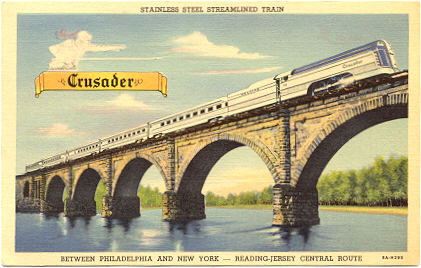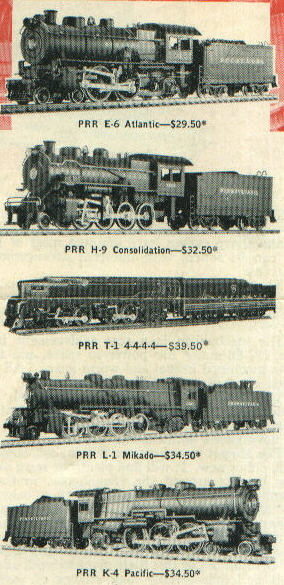 |
Abe Mercer's "World's Smallest Layout" |
A Short History of Penn Line |
By Frank Dill |
The Early Years |
|
The very first "Production" consisted of
casting in a one room rented from Carver's Dairy on Chestnut Street
in Boyertown Pennsylvania. The work of assembling the parts of the
locomotive kits was done in one of the partner's apartments. This
was the address 41 N. Reading Avenue that would appear on the early
products. The apartment house has since been torn down.
1) They realized that the time was right.The three partners made some very good decisions during this period. I will mention just three and say a little about each decision: 2) They realized that the future of model railroading was probably HO scale rather than larger scales such as Lionel and American Flyer had been using. 3) They realized that true modelers wanted greater realism. First the timing. Large companies like A.C. Gilbert had suspended model train production during World War II. And frankly the prewar model trains left a lot to be desired in terms realism. Next the decision to go to HO scale. Back in 1946 most model trains were built in the larger O or S scale. A common display was a single loop set up on the floor around the Christmas Tree. This made for very temporary layouts. Serious model railroad enthusiasts took time to construct their layouts. A reasonable HO scale layout could be made on a 4'x8' surface, a very interesting HO scale layout could be built on a couple of 4'x8' boards kept set up year round. While HO scale is the most popular today, it took foresight to choose HO in 1946. Even A.C. Gilbert Company, which recognized the trend, only down sized to S scale in 1946. |
 |
Abe Mercer's "World's Smallest Layout" |
|
In an effort to demonstrate the potential of
HO, Penn Line's Abe Mercer built what he called "the world's smallest
layout." This consisted of Penn Line's diesel switcher turning
on a track where the inside rail was a silver dollar. Such a layout
stood outside Penn Line's office on Franklin St. There is a push button
that would start the switcher running to the delight of all visitors.
You can read a little of Abe Mercer's ideas here
, here , and here. The third sound decision made during this period was to make the locomotives by die casting with printer's lead. This allowed very good detail and made the locos heavy enough to pull many cars. Some of Penn Line's ads claimed a hundred calls pulled. In an article in the Boyertown Times, November 30, 1995, Stauffer only admits to a record of 78 cars pulled. This is a short article, very interesting, but hard to find. The decision to use die casting mold and stamping dies was a sound one. It meant that there would be no shortage workers in the area. Boyertown with a population of about 4 thousand had at least a half dozen metal working related industries. A tradition dating back to the early 1700's when the Potts family were involved in iron mining and production at the Colebrookdale foundry. One decision not quite so sound was the combination of choosing a name for the company and producing the first product. The name Penn Line was chosen because their plan was to model Pennsylvania Railroad locomotives. This was good because The Pennsy used fairly universal locomotives, that with just some decals and accessory additions would look trains that could been seen in any part of the country. The problem was the the very first locomotive they produced was the Reading Railroad Crusader. This an extremely beautiful locomotive, but it was only used by the Reading Railroad for the Philadelphia-Jersey City route. |
 |
You can see from this postcard that the Reading
Railroad Crusader had a very unusual look. The Penn Line model
captured this look extremely well. But unless you actually had seen
the Crusader in operation you might not appreciate its realism. And
of course one could only see it along the Philadelphia-Jersey City
route. Realism and reproduction of the locomotives of the Pennsylvania
Railroad was the goal of Penn Line. Because of this conflict,
only one production run of the Penn Line's Crusader was made. It
remains today by far the most valuable Penn Line locomotive.
|
|---|
 |
|
In the early years of the company new locomotives
were added to the line at a rate of about one a year. They were sold
mainly as built-it-yourself kits. The market for their products was
clearly the serious model railroad enthusiast. Only one kit was simple
enough for a youngster to assemble. That was the Whitcomb Midget Diesel
Switcher. The other kits competed in quailty and precision with anything
on the HO market at that time. |